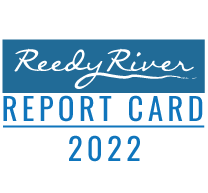Are there terms or phrases in this report that you're wondering about? Look no further!
Dissolved Oxygen
Dissolved Oxygen is the amount of gaseous oxygen (O2) dissolved in the water. Oxygen enters the water by direct absorption from the atmosphere, by rapid movement, or as a waste product of plant photosynthesis. Water temperature and the volume of moving water can affect dissolved oxygen levels. Oxygen dissolves easier in cooler water than warmer water.
Adequate dissolved oxygen is important for good water quality and necessary to all forms of life. Dissolved oxygen levels that drop below 5.0 mg/L cause stress to aquatic life. Lower concentrations cause greater stress . Oxygen levels that go below 1-2 mg/L for a few hours may result in large fish kills.
Nitrogen and Phosphorus Pollution
Nitrogen and phosphorus are nutrients that are natural parts of aquatic ecosystems. Nitrogen is also the most abundant element in the air we breathe. Nitrogen and phosphorus support the growth of algae and aquatic plants, which provide food and habitat for fish, shellfish and smaller organisms that live in water.
But when too much nitrogen and phosphorus enter the environment - usually from a wide range of human activities - the air and water can become polluted. Nutrient pollution has impacted many streams, rivers, lakes, bays and coastal waters for the past several decades, resulting in serious environmental and human health issues, and impacting the economy.
Too much nitrogen and phosphorus in the water causes algae to grow faster than ecosystems can handle. Significant increases in algae harm water quality, food resources and habitats, and decrease the oxygen that fish and other aquatic life need to survive. Large growths of algae are called algal blooms and they can severely reduce or eliminate oxygen in the water, leading to illnesses in fish and the death of large numbers of fish. Some algal blooms are harmful to humans because they produce elevated toxins and bacterial growth that can make people sick if they come into contact with polluted water, consume tainted fish or shellfish, or drink contaminated water.
Rainbow Reedy
The Reedy River was once home to many fabric and textile mills. Facilities such as Monaghan Mill, American Spinning, Poe Mill, Poinsett Mill, and Union Bleachery discharged their wastes and excess colored dyes indiscriminately into the river. For many years the Reedy’s waters would flow with a plethora of colors—depending on which dye was being discarded on any particular day. The “Rainbow Reedy” was its nickname.
